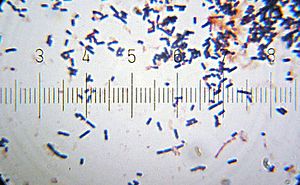ラクトバチルス・アシドフィルス
Lactobacillus acidophilus/ja
ラクトバチルス・アシドフィルス(Lactobacillus acidophilus)(新ラテン語「酸を好む乳酸菌」)は、1900年に乳児の糞便から初めて分離された、棒状のグラム陽性菌、同種発酵、嫌気性菌の微生物である。この種は最も一般的にヒト、特に消化管、口腔、膣、および発酵乳やヨーグルトなどの様々な発酵食品に存在する。この種は低pHレベル(5.0以下)で最も増殖しやすく、至適増殖温度は37℃である。ある種のL. acidophilus株は強いプロバイオティクス効果を示し、酪農生産に商業的に利用されている。L.アシドフィルスのゲノムは解読されている。
| Lactobacillus acidophilus/ja | |
|---|---|

| |
| "ラクトバチルス・アシドフィルス", 数字の目盛りは11 μm | |
| Scientific classification | |
| Domain: | Bacteria |
| Phylum: | Bacillota |
| Class: | Bacilli |
| Order: | Lactobacillales |
| Family: | Lactobacillaceae |
| Genus: | Lactobacillus |
| Species: | acidophilus
|
| Binomial name | |
| acidophilus | |
L.アシドフィルスは黄色ブドウ球菌、大腸菌、サルモネラ・チフス菌、クロストリジウム・ペルフリンゲンスの増殖に対して拮抗作用を示す。この4菌のうち、最も影響を受けるのは黄色ブドウ球菌である。黄色ブドウ球菌と並んで、もう1つのグラム陽性菌であるC. perfringensは、グラム陰性菌である他の2つの菌よりも、L. アシドフィルス菌の影響を強く受けた。L.アシドフィルスは、ストレプトコッカス・ミュータンスによる口腔プラーク形成も減少させることが判明している。
歴史
ラクトバチルス・アシドフィルスは、1900年にエルンスト・モロ(Ernst Moro)によってヒトの消化管から初めて分離され、当初の名称はBacillus acidophilusであった。時を経て、生物の分類学的特徴を明らかにする方法には多くの変化があり、1929年にLactobacillusという属分けに至った。1つの分離株から複数の菌株が分離され、様々な名前が付けられると、原菌株を見つけるのが難しくなる。L.アシドフィルスに関する研究のほとんどは、ラクトバチルス・アシドフィルスNCFMという1つの菌株に焦点を当てたものであった。L.アシドフィルス菌NCFMに関する大量の情報が発見されたことで、米国食品医薬品局は、この微生物を飲料、乳製品、その他のプロバイオティクス食品の認可成分であると判断した。
生物学的および生化学的特徴
形態学的特徴
ラクトバチルス・アシドフィルスは、大きさが2-10μmである、動かない棒状の(桿菌)グラム陽性生物である。アシドフィルスはリン脂質二重層膜を持ち、膜の外側にはペプチドグリカンからなる大きな細胞壁がある。L.アシドフィルスの細胞壁はテイコ酸と表面タンパク質が織り成すもので、陰イオン性多糖類と中性多糖類、そして細胞の外側を覆うS層がある。L.アシドフィルス菌のS層タンパク質は、粘液や他の細胞外タンパク質だけでなく、上皮細胞にも接着することが示されている。S-層は2つの構造ドメインからできている。C末端ドメインは細胞壁の固定を担い、N末端ドメインは細胞環境との相互作用とS層の自己形成を担っている。L.アシドフィルス属では、N-末端領域はアミノ酸変異が大きく、配列相同性も低い(31-72%)。L.アシドフィルス菌は、鞭毛やピルのような細胞外運動手段を持たないため、動かない微生物である。
代謝
アシドフィルスはホモ発酵性嫌気性微生物であり、発酵の最終産物として乳酸のみを産生する。また、EMP経路(解糖系)によりヘキソース(ペントースではない)のみを発酵させることができる。L.アシドフィルスは、利用可能な栄養素が限られているため、宿主の中にいるときよりも牛乳の中で成長する時間が遅い。牛乳中のプロバイオティクスとして使用されているため、アメリカのJournal of Dairy Scienceが行った研究では、L. アシドフィルスの低い増殖速度を上げるために必要な栄養素を調べた。この研究では、グルコースとアミノ酸システイン、グルタミン酸、イソロイシン、ロイシン、リジン、メチオニン、フェニルアラニン、スレオニン、チロシン、バリン、アルギニンがL. アシドフィルスの増殖に必須な栄養素であることがわかった。グリシン、パントテン酸カルシウム、Mn2+は刺激性栄養素として作用する。この研究は、牛乳中のアシドフィルス菌の増殖率が低いことを説明するのに役立つ。消費率の高いアミノ酸を発酵乳に加えることは、この問題の解決策になりうる。
ゲノム科学
原核生物のゲノムの特殊性は、複製の際に原核生物がどのようにDNAを複製するかを認識することで区別できる。L.アシドフィルスでは、複製はoriCと呼ばれる起点から始まり、複製フォークの形で双方向に移動する。DNAは先導鎖上では連続的に、遅行鎖上では不連続な岡崎フラグメントとして、|DNAポリメラーゼIII酵素の助けを借りて合成される。先行鎖と遅行鎖のDNA合成を開始するには、RNAプライマーが必要である。DNAポリメラーゼIIIは、RNAプライマーに従って5'から3'方向にDNAを合成する。L.アシドフィルス菌のゲノムは小さく、グアニン-シトシン含量は約30%と低い。様々なL. アシドフィルスの46株のゲノムを比較した研究によると、ゲノムのサイズは1.95Mbから2.09Mbで、平均サイズは1.98Mbであった。ゲノム中の平均コード配列数は1780個で、発酵食品や市販のプロバイオティクスから分離された株は、ヒトから分離された株よりも平均してコード配列数が多かった。L.アシドフィルスはオープンな状態のパンゲノム(種内の全遺伝子)を持っており、シーケンシングされたゲノムの数が増えるにつれてパンゲノムのサイズが大きくなることを意味している。コアゲノム(種の全個体が共有する遺伝子)は、L. アシドフィルスの場合、約1117遺伝子で構成されている。 遺伝子解析の結果、すべてのL. アシドフィルス株が、糖質代謝の主要酵素であるグリコシルヒドロラーゼの少なくとも15ファミリーを含んでいることも明らかになった。15のGHファミリーはそれぞれ、グルコース、ガラクトース、フルクトース、スクロース、デンプン、マルトースなどの一般的な炭水化物の代謝に関与していた。抗生物質の排出、抗生物質の標的変更、および抗生物質の標的防御による抗生物質耐性をコードする遺伝子は、すべてのL. アシドフィルス株に存在し、すべての株で18種類の抗生物質に対する防御を提供していた。フルオロキノロン系、グリコペプチド系、リンコサミド系、マクロライド系、テトラサイクリン系は、L. アシドフィルスが最も高い耐性を示した5つの抗生物質クラスであり、これらのクラスに関連する300以上の遺伝子が存在した。
環境
L.アシドフィルス菌は、哺乳類の口腔、腸、膣腔で自然に増殖する。ほぼ全ての乳酸菌種は、シャペロンの活性を高めることを含む耐熱性のための特別なメカニズムを持っている。シャペロンは高度に保存されたストレスタンパク質であり、高温に対する抵抗性の強化、リボソームの安定性、温度感知、高温でのリボソーム機能の制御を可能にする。この高温で機能する能力は、発酵過程における細胞の収量にとって極めて重要であり、現在、L. アシドフィルスの温度耐性を高めるための遺伝子検査が行われている。プロバイオティクスとして考える場合、L. アシドフィルスが消化管での生活に適した形質を持つことが重要である。低いpHや高い毒性レベルに対する耐性がしばしば要求される。これらの形質は様々であり、菌株特異的である。これらの耐性が発現されるメカニズムには、細胞壁構造の違いや、その他のタンパク質発現の変化が含まれる。塩濃度の変化はL. アシドフィルスの生存率に影響を与えることが示されているが、それはより高い塩濃度にさらされた後のみである。米国酪農科学協会が注目した別の実験では、生存細胞数は7.5%以上の濃度のNaClに暴露した後にのみ有意な減少を示した。また、NaCl濃度10%以上の条件下で培養した場合、細胞は明らかに伸長することが観察された。L.アシドフィルスは乳製品培地での生育にも非常に適しており、発酵乳はL.アシドフィルスを腸内細菌叢に導入する理想的な送達方法である。噴霧乾燥技術によってカプセル化されたL. アシドフィルス細胞の冷蔵保存(4 °C)の生存率は、室温保存(25 °C)の生存率よりも高い。
クォーラムセンシング
細胞間のクォーラムセンシングは、細胞シグナル伝達が協調的な活動につながり、最終的に細菌が遺伝子発現を連続的に制御するのに役立つプロセスである。これは、細胞数の増加に反応して分泌される小さな自己誘導物質の検出によって達成される。消化管に生息するラクトバチルス・アシドフィルスでは、バイオフィルム形成や毒素分泌を考慮すると、クオラムセンシングは細菌間の相互作用に重要である。L.アシドフィルス菌では、他の多くの細菌とともに、luxSを介したクオラムセンシングが行動の制御に関与している。単培養では、luxSの産生は指数関数的増殖期に増加し、定常期に進むにつれてプラトーになる。L.アシドフィルスを他のラクトバチルス種と共培養すると、luxSのアップレギュレーションが起こりうる。
Vaginal microbiota
Lactobacillus acidophilus is part of the vaginal microbiota along with other species in the genus including Lactobacillus crispatus, Lactobacillus gasseri, Lactobacillus jensenii, and Lactobacillus iners. In experiments, L. acidophilus seemed to decrease Candida albicans’ ability to adhere to vaginal epithelial cells; however, L. acidophilus’ role in preventing yeast infections is unclear because this species of Lactobacilli has also been found not to have a very strong ability to adhere to (and thereby colonize) the vaginal cells.
Therapeutic uses
Research has shown that the presence of L. acidophilus can produce a variety of probiotic effects in humans, such as acting as a barrier against pathogens, assisting in lactose digestion, enhancing immune response, and reducing cholesterol level. L. acidophilus must exist in concentrations of 10^5 - 10^6 c.f.u (colony-forming units) per mL in order for these effects to be seen. A study conducted at the Wake Forest School of Medicine examined the effects of L. acidophilus on the structure and composition of the gut microbiome of mice with respect to the age of the mice. The research established the importance of the interactions between microbes within a gut microbial environment on the overall health of the organism, and the data showed that mice supplemented with L. acidophilus had reduced proteobacteria levels, and increased levels of other probiotic bacteria when compared to other mice of similar age. Another study conducted at Maranatha Christian University studied the impact of L. acidophilus cell free supernatants (a liquid medium containing the metabolites produced by microbial growth) on the growth pattern Salmonella typhi, the microbe assiciated with Typhoid fever. The study showed that the presence of L. acidophilus metabolites significantly inhibited the growth curves displayed by S. typhi, supporting the idea that L. acidophilus presence has a positive impact on the species makeup of a gut microbial community, providing the organism with intestinal health benefits. The innate immune system of L. acidophilus also produces antimicrobial peptides. The group of short peptides found there have shown antimicrobial properties such as their strength against viruses and other cell types, including cancer cells. There is also some evidence supporting the use of a symbiotic gel (containing L. acidophilus) in treating gastrointestinal symptoms in patients who had received a hemodialysis treatment. This gel also reduced the occurrence of vomit, heartburn, and stomachaches. Further study concerning this subject is needed to draw firm conclusions.
Dairy industry usage
As stated in a journal from the American Dairy Science Association, "Lactobacillus acidophilus is a commercial strain and probiotic that is widely used in the dairy industry to obtain high-quality fermentation products." Increased levels of beneficial bacteria, and decreased levels of pathogenic bacteria within the intestine due to the consumption of fermented milk containing strains of L. acidophilus has a range of probiotic effects. Reduced serum cholesterol levels, stimulated immune response, and improved lactic acid digestion are all probiotic effects associated with intestinal L. acidophilus presence. L. acidophilus was also effective in reducing Streptococcus mutans levels in saliva, as well as decreasing risk factors associated with the development of nonalcoholic fatty liver disease. The strain of L. acidophilus that has been most widely researched, and is most widely used as an antibiotic and is referred to as NCFM.
Side effects
Although probiotics are generally safe, when they are used by oral administration there is a small risk of passage of viable bacteria from the gastrointestinal tract to the blood stream (bacteremia), which can cause adverse health consequences. Some people, such as those with a compromised immune system, short bowel syndrome, central venous catheters, cardiac valve disease and premature infants, may be at higher risk for adverse events.
こちらも参照
外部リンク
- Lactobacillus at MedlinePlus
- Lactobacillus acidophilus at University of Maryland Medical Center
- Lactobacillus acidophilus from the U. of Wisconsin
- Global analysis of carbohydrate utilization by Lactobacillus acidophilus using cDNA microarrays
- Safety and protective effect of Lactobacillus acidophilus and Lactobacillus casei used as probiotic agent in vivo
- Pictures and research on Lactobacillus acidophilus Archived 2017-07-01 at the Wayback Machine
- Type strain of Lactobacillus acidophilus at BacDive – the Bacterial Diversity Metadatabase
- Lactobacillus acidophilus - Benefits & Probiotic Uses at Pocket Reviewer